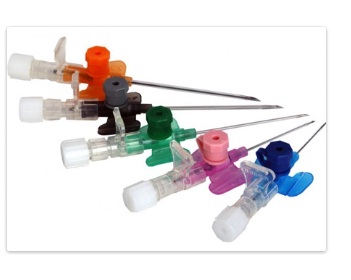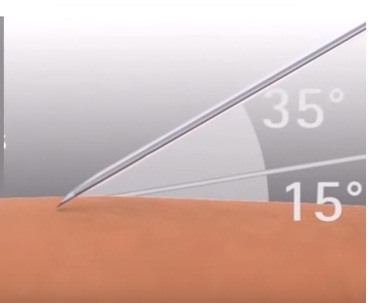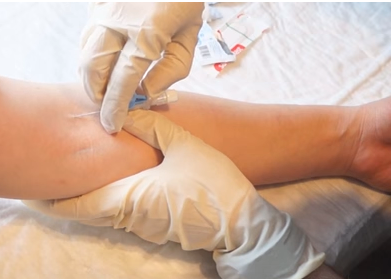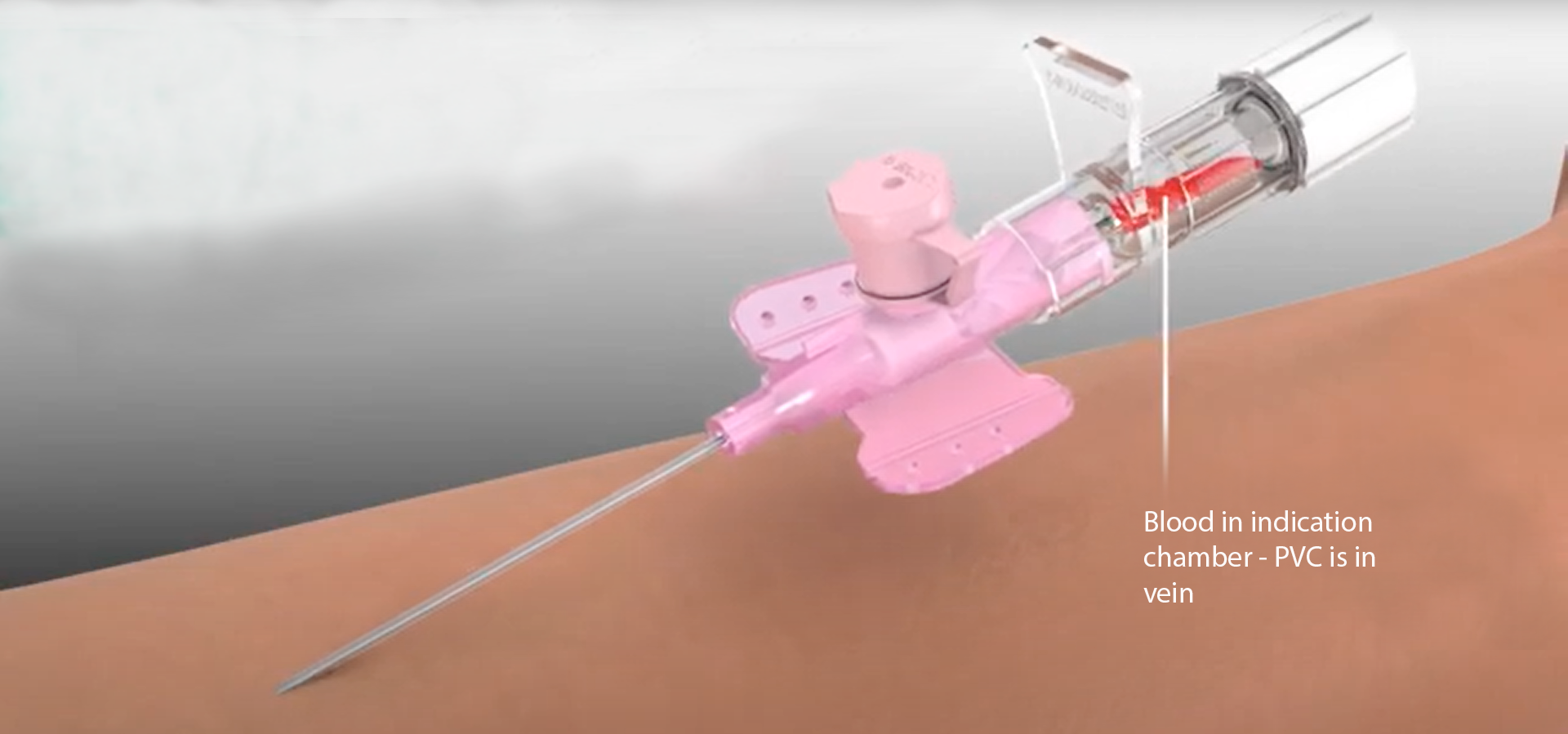Setting of PVC (peripheral venous catheter)
Патрабаваньні выкананьня
Authors: Rednenko V.V., Poplavets E.V., Tolyaronok D.A.
Editor: Rednenko V.V.
Equipment for the practical skill:
- medical manipulation table
- disinfection table
- medicines:
- heparin solution in a 5 ml vial (5000U/1ml)
- sodium chloride solution of 9 mg/ml in a 100 ml vial
- sodium chloride solution of 9 mg/ml in an 5 ml ampoule
- ampoule knife
- peripheral intravenous (venous) catheter (PVC)



- 5 ml syringes with a needle size of 0.8x40 mm (2 pcs.)
- sterile dressings in individual packaging (individual packaging: 9-10 balls, 2 napkins)
- self-adhesive dressing (plaster) for fixing the catheter
- non-sterile dressing material (gauze in size 5х10cm)
- venipuncture pillow
- venous tourniquet
- scissors
- PPE
- solution of skin antiseptic
- emergency chemical disinfectant for disinfection of ampoules and vials, external surfaces
- containers for disinfection with working solution of a chemical disinfectant:
- "Rinsing of syringes and other medical devices"
- "Disinfection of syringes and other medical devices"
- "Disinfection of dressings and PPE"
- "Disinfection of sharp medical devices"
- medical waste containers:
- "Empty ampoules"
- "Empty vials"
- "Plastic"
- "Packaging"
- «For temporary placement of syringes»
- anatomical tweezers in a container with a disinfectant solution (to work with medical waste containers)
- anatomical tweezers in a container with a disinfectant solution
- non-sterile gloves
- treatment list
Level of assistance:
- Hospital and outpatient health care facilities
Clinical situation:
- The patient was prescribed an intravenous infusion of a drug solution using a peripheral venous catheter.
Order of the skill performance:
- Inform the patient about the injection, get verbal consent to giving it, ask him to take the required position
- Prepare the workplace for intravenous infusion ( see «Preparing the workplace for intravenous infusion»)
- Take and place on the manipulation table the medical equipment required additionally for the catheterization of peripheral veins
- heparin solution in a 5 ml vial (5000U/1ml)
- sodium chloride solution of 9 mg/ml in a 100 ml vial
- sodium chloride solution of 9 mg/ml in an 5 ml ampoule
- peripheral venous catheter of the required size
- container «For temporary placement of syringes»
- 2 syringes of 5 ml with needles of 0.8x40 mm (2 pcs.)
- bandage in size 5х10 см
- sterile dressings in individual packaging (individual packaging for catheterization of peripheral veins: 9-10 balls, 2 napkins, self-adhesive dressing (plaster) for fixing the catheter)
- Check:
- the name and dose of drugs on ampoules and vials with an entry in the treatment list
- ampoule and vial of medicines, their appearance, expiration date
- the integrity of the packaging of sterile medical items and sterile dressings
- Perform hygienic hand antiseptics
- Take the anatomical tweezers from a container with a disinfectant solution
- Open package with sterile dressings, take from it an individual package with sterile dressing material, place it on the table
- Return the tweezers to the container with the disinfectant solution
- Open the individual packaging with sterile dressing material with your hands
- Prepare a syringe with a sodium chloride solution for washing PVC:
- treat and open the ampoule with 5 ml of 9 mg/ml sodium chloride solution (see "Withdrawing of medicine from an ampoule")
- take a 5.0 ml syringe, connect to it the needle and withdraw from an ampoule 5 ml of sodium chloride 9 mg / ml (see "Withdrawing of medicine from an ampoule")
- after removing the needle from the ampoule, transfer the syringe to your left hand, place the second finger on the needle cannula, grasp the syringe barrel with others fingers
- place the second and third fingers of the right hand on the flange of the syringe cylinder, the first finger on the piston
- expel the air from the syringe by pressing the plunger of the syringe with the first finger of your right hand
- remove the needle from the syringe with the first and second fingers of the left hand, place it in the container "Disinfection of sharp medical devices"
- place the syringe (without a needle!) with with 5.0 ml of 9 mg/ml into the opened packaging from the syringe.
- Prepare a heparinized solution:
- treat and open a vial with a 9 mg/ml sodium chloride solution of 100 ml and a vial with a heparin solution (see "Withdrawing of medicine from a vial")
- take a 5.0 ml syringe, connect to it the needle and withdraw it 1 ml of heparin solution (see "Withdrawing of medicine from a vial")
- place the vial with heparin solution on the manipultion table
- take a 100 ml vial with a 9 mg/ml sodium chloride solution in your left hand
- carefully pierce the rubber stopper with a needle
- administer into the vial the heparin solution, holding the vial by your left hand by pressing on the syringe plunger with the first finger of the riht hand
- separate the syringe from the needle by rotating, holding the needle cannula with the first and second fingers of the left hand
- mix the solution gently jiggling the vial with your left hand
- connect the syringe to the needle cannula, lift the vial and turn it upside down
- withdraw into a syringe 3 ml of heparin solution (see "Withdrawing of medicine from a vial")
- remove the needle from the vial
- place the vial on the manipultion table
- after removing the needle from the vial, transfer the syringe to your left hand
- place the second finger of the left hand on the cannula of the needle, with the other fingers grasp the cylinder of the syringe
- place the second and third fingers of the right hand on the flange of the syringe cylinder, the first finger on the piston
- discard the air from the syringe and dose the heparinized solution by pressing the plunger of the syringe with the first finger of your right hand
- remove the needle from the syringe with the first and second fingers of the left hand, place it in the container "Disinfection of sharp medical devices"
- place the syringe (without a needle!) with a heparinized solution into the opened packaging from the syringe
- indicate on the label of the vial with heparinized solution "Heparinized solution 1:100", the date and time of preparation, put the signature of the person who prepared the solution
- Determine the location of the PVC placement (for the placement PVC, you should choose veins with the presence of a straight section, corresponding to the length of PVC; on a non-dominant hand; well visualized and palpable in the area of the back surface of the hand, the inner surface of the forearm, the ulnar fossa)
- Perform hygienic hand antiseptics
- Open the package with gauze napkins, PVC.
Main stage:
- place a pad under a patient's shoulder
- put a tourniquet on patient's shoulder
- take two swabs, wet it with skin antiseptic
- treat the skin at the injection site: with one swab a “large field” (10x10 cm in size), with second one the "small field" (size 5x5 cm) 2-3 times from the periphery to the center
- place the used swabs in the container “Disinfection of dressings, PPE”
- perform hygienic hand antiseptics, put on gloves
- prepare the PVC for use
- take the PVC from the opened package with your left hand.
- remove the plug with your right hand, without removing the camera plug, put the plug in the PVC packaging or on a gauze napkin
- spread the wings slightly on the PVC
- transfer the PVC to the right hand, place the second and third fingers in front of the wings, the first finger — on the detent for the first finger
- remove the cap from the guide needle with your left hand, place the cap in the "Plastic" container
- fix the vein by pulling the skin in the venipuncture area with the first finger of the left hand
- holding the guide needle with the cut up, pierce the skin at a slight angle (no more than 15°), place the guide needle parallel to the vein, without changing the position of the PVC in the hand


- continuing to fix the vein, slightly change the direction of the guide needle, pierce the front wall of the vein and carefully push the guide needle along the vein until blood appears in the needle cannula

- transfer the first finger of your right hand to the cover of the additional port
- grasp detent for the first finger by the first and second fingers of the left hand
- hold the guide needle motionless with your left hand by the detent for the first finger and gently push the PVC in the vein with your right hand to the cannula, do not remove the guide needle completely from the catheter (do not return the guide needle to the catheter in order to avoid cutting off the catheter and its migration through the bloodstream)
- remove the fingers of the left hand from the detent for the first finger and untie the tourniquet with your left hand, invite the patient to unclench his fist
- place the first finger of your left hand on the cover of the additional port, the third finger of the left hand is at the intended location of the tip of the PVC, remove the fingers of your right hand from the PVC
- press the vein with the third finger of your left hand at the intended location of the tip of the catheter
- take a gauze napkin with your right hand and place it below the venipuncture site under the main catheter port
- grasp the guide needle with the first and second fingers of your right hand, remove it completely
- place the guide needle in the container "Disinfection of sharp medical devices"
- rinse the catheter with a 9 mg/ml sodium chloride solution:
- take a syringe with 5.0 ml of sodium chloride 9 mg / ml by your first,econd and third fingers of the right hand, place the scale of the syringe barrel in front of you
- connect the syringe with 5.0 ml of sodium chloride 9 mg / ml by rotating movement to the main port of PVC
- place the second and third fingers of the right hand on the flange of the syringe cylinder, the first finger on the piston
- loosen the pressure of the third finger of the left hand on the vein at the intended location of the tip PVC
- slowly inject a sodium chloride solution of 9 mg / ml, pressing the plunger of the syringe with the first finger of the right hand, leaving 0.5—1.0 ml of the solution in the syringe
- press the vein with the third finger of the left hand at the intended location of the tip of the PVC
- grasp the syringe with the remaining 9 mg/ml sodium chloride solution with the first, second and third fingers of the right hand, disconnect the syringe from the PVC with a rotational movement
- place the syringe into the container for temporary placement of medical syringes
- take the plug with the first and second fingers of the right hand from a sterile napkin or from an opened package of PVC, close the main port of PVC with a plug by rotational movement.
- remove the third finger of the left hand from the intended location of the tip of the PVC.
- inject heparinized solution:
- place the first and the second fingers of your left hand on the catheter wings, with the fingers of your right hand open the injection port cap
- take a syringe with 3.0 ml of heparinized solution with your right hand connect it to the injection port by rotating movement
- place the second and third fingers of your right hand on the flange of the syringe barrel, the first finger on the plunger
- slowly inject 2.0-2.5 ml of heparinized solution pressing the plunger of the syringe with the thumb of your right hand, leaving 0.5-1.0 ml of solution in the syringe
- disconnect the syringe from the IV infusion port of the catheter by rotating movement
- place the syringe in a container for temporary placement of medical items
- close the injection port cap with your right hand
- treat the skin around the catheter:
- remove the gauze pad with your right hand, holding the catheher wings with the first and second fingers of your left hand, place the gauze napkin in the container "Disinfection of dressings and PPE"
- take one cotton ball with your right hand and wet it with skin antiseptic
- treat the skin around the PVC by circular motion from the center to the periphery
- place the ball in the container "Disinfection of dressings and PPE"
- remove the fingers of your left hand from the catheter wings
- wait until antiseptic has completely evaporated from the surface of the skin
- fix the PVC with a self-adhesive bandage,according to the manufacturer's instructions, indicating the time and date of setting the PVC (in the case of PVC fixation with a band-aid, it is impossible to seal the catheterization site with a "blind" plaster bandage in order to avoid the accumulation of exudate at the site of venipuncture and the development of complications).

- cover PVC with a gauze napkin and put on bandage)
- inform the patient that it is impossible to remove the bandage and moisten the venipuncture site with water
Final stage:
- take the syringes from the container for temporary placement of syringes, rinse in the container "Washing syringes and other medical items" and the disassembled syringes place in the container “Disinfection of syringes and other medical items”
- take off your gloves, place in the container “Disinfection of dressings, PPE”
- wash your hands
- register in the medical documentation the time and date of the PVC setting
- disinfect the external surfaces.
Апошняя зьмена: пятніца, 17 сакавіка 2023, 11:42 AM